|
Miss Clara Conway
...
and the Clara Conway Institute |
|
|
|
|
|
Clara Conway was a highly motivated and dedicated Memphis
teacher and political activist. She founded the
Clara Conway Institute in Memphis and was a founding member of
the
Nineteenth Century Club
in 1890. She began her career as a city public school
teacher and developed a strong interest in providing women
with a quality education. Conway was the first
Tennessee woman to assist in the organization of teachers'
institutes, and the first southern woman to attend teachers'
summer school in the north. She was also instrumental in
getting a Tennessee bill passed which confirmed that women
could be eligible to become school superintendents.
|
 |
|
|
|
|
|
|
|
|
|
|
Click on small
photos to see an enlargement |
|
|
|
|
|

Clara Conway
|
Clara Conway was born in New Orleans August 14, 1844. She
moved to Memphis in 1864 and was
educated at St. Agnes Academy, but her main education was
by her own study at home. She traveled extensively in the United
States and in Europe and her special gift was to prepare girls for
college – primarily the top two girl's schools, Vassar and
Wellesley.
| |
|
|
Early in her career, Conway was principal of the Memphis Alabama
Street School and the Market Street School. She was
considered an outstanding teacher and was frequently featured in the
newspapers.
In 1873, Conway was proposed for
superintendent of public schools in Memphis. This was part of
an early political fight to have female educators recognized for
their merits. The Memphis Daily Appeal endorsed her, but she
didn't get the position and of course, women teachers didn't get
equal pay. |
 |
| |
|
|
| |
|
|
|
|
|
|
|
|
|
In 1877 Clara Conway left her prominent position in the public
schools to open a high-grade school for girls.
She began with 50 pupils, one assistant, and $300 of borrowed money.
The aim of her school was to help women become economically
independent through a solid education. To Conway "independence"
was one of highest attributes of womanhood. But without
backing, starting a new school was not easy
In 1884-85 a number of public-spirited citizens of
Memphis came to her assistance. They
organized a stock company, incorporated the school, and erected a
building.
|
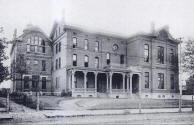 |
| |
Clara Conway
Institute |
|
|
|
|
|
|
|
|
Miss Conway proposed
to call the new school the Margaret Fuller School, but instead, the
trustees wanted it named the Clara Conway Institute.
From the small beginning the institute became very
successful. The school's board of Trustees included some of the most
influential businessmen in the city. |
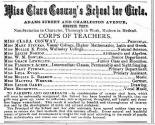 |
| |
The Teaching Staff |
|
|
|
|
|
|
|
 |
In the Clara Conway Institute there was a
Kindergarten - which was a new idea in Memphis. Here, the little children
learned unconsciously and acquired a solid foundation for future education
and for life. Conway also introduced physical
education into her school, as well as "free-hand drawing" along with
other branches that required mind and hand coordination. Her
belief was to educate "... morally, mentally, and physically"
Her school had a fine reference library, a well-equipped gymnasium,
a science lab, and a complete arts studio. There were courses in
voice, piano, theory, and public speaking. Over the years
Conway won
the friendship of famous artist, musicians, authors and scientists.
|
| Clara Conway |
|
|
|
|
|
|
|
|
|
|
|
|
|
Clara Conway had hoped to found a school that would make women
economically independent and she believed a solid education would do
this. She became one of the most prominent figures in education in
the South and her school held a unique place in the region as a
major preparatory school for young women.
The school grew rapidly and by 1885
there were 270 pupils. During this year the school was
incorporated and the name Clara Conway Institute chosen. It
was also the year that a large building was erected on Poplar
Avenue. The school soon outgrew this building and a larger
modern brick structure was erected.
|
 |
| |
1885
Dedication |
|
|
|
|
|
|
|
|
|
|
In 1888 there were over 300 pupils
and 26 teachers - many of whom had been graduates of the school.
The course of the school consisted of eleven years work, and the
last year included trigonometry, poetry and history of Horace and Herodotus, history of
philosophy, history of art, English literature, political economy,
and civil government.
Many national leaders in education
complimented the work of the school. It became nationally
known for its
progressive and innovative approach to education. The two
articles below were written 100 years apart, in "Cosmopolitan" -
1891, and in the book "Elite Women of the Reform Impulse" -
1991. |
 |
| |
1893 Article |
|
|
|
|
|
|
|
|
|
|
|
|
The Clara Conway Institute continued until 1893. The circumstances
of the school's demise are somewhat unclear but appear to have
originated from a conflict between Conway and her trustees. She was
determined to carry out the college-preparatory idea over the
opposition of her financial backers who wrote that there was
"too much ambition on the part of the principal" |
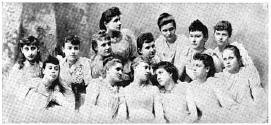 |
| |
Class of
1891 |
|
|
|
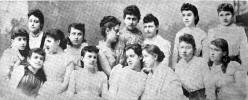 |
After the closure of her school, Clara Conway continued to teach for
a few years on a much smaller scale, with herself as the sole
teacher.
She also remained heavily involved in educational issues for women
and spoke at the National Educational Associations meetings in 1884,
1886, 1887. She was elected a member of the National Council.
Her activism was motivated by women's independence. She argued
that a woman's duty is first and foremost to herself, not to her
husband. In 1889 a bill was finally passed confirming women's
eligibility as school superintendents.
|
|
Class of
1891 ... with Conway
|
|
|
|
|
|
In 1902, Conway
published a small 97 page book
titled, "Silver-Lined Days - Leaves from a note book of
old-world travel". The book is about a Southern
woman's description of travel through Europe at the turn of the
century. It's a very hard book to locate, but occasionally
a copy will show up on EBay. It sells for around $125.00. |
 |
| |
Conway Book
|
|
|
|
|
|
|
Clara Conway's
influence on students was deep and lasting. She died in
1904 and is buried at Calvary Cemetery.
|
|
|
 |
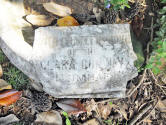 |
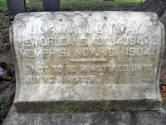 |
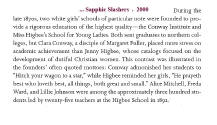 |
| Conway Grave |
Conway Grave |
Conway
Marker |
2000 Article |
|
|
|
|
|
|
|
|
|
|
|
In 1890, Conway was among a group
of the elite women in Memphis who assembled at the Gayoso Hotel and
founded the Nineteenth Century Club - whose aim was to improve city
life and public services. The club primarily focused on the
needs of women and children, addressing public problems such as
sanitation, health, education, employment and labor conditions.
The club was immediately successful, with membership steadily rising
and peaking at around 1400 members in 1926. In 2013 the
Nineteenth Century Club sold their building and made plans to
disband after finalization of the sale. |
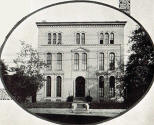 |
| |
1904 . 19th
Century Club |
|
|
|
|
|
|
|
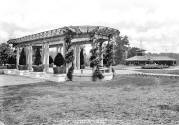 |
Like Memphis teacher Jenny Higbee before her,
Clara Conway was honored with a beautiful memorial in Overton Park.
The Conway Memorial Pergola was erected by grateful pupils and admiring friends in 1908.
Sadly the memorial was destroyed in a 1936 windstorm and was not
replaced. |
|
Clara Conway
Pergola |
|
|
|
|
|
|
|
|
|
|
|
|
|
After the Conway Institute
closed, the Conway building was leased by the New
University School for several years until they outgrew it. In 1906, Sacred Heart High
School took over the old Clara Conway Institute school building
on Poplar. They later moved to the corner of Jefferson and
Cleveland. |
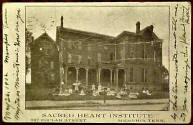 |
| |
Sacred Heart
High |
|
|
|
|
|
|
|
|
|
|
|
|
|
|
|
|
|
|
|
|
Credits |
|
|
|
The
Historic-Memphis website does not intentionally post copyrighted
photos and material without permission or credit.
On
occasion a "non-credited" photo might possibly be posted because we
were unable to find a name to give credit. Because of the nature of
our non-commercial, non-profit, educational website, we strongly
believe that these photos would be considered "Fair Use. We have
certainly made no monetary gain, although those using this website
for historic or Genealogy research have certainly profited. If by
chance,
we have posted your copyrighted photo, please contact us, and we'll
remove it immediately, or we'll add your credit if that's your
choice. In the past, we have found that many photographers
volunteer to have their works included on these pages and we'll
also do that if you contact us with a photo that fits a particular
page. |
|
|
|
The "Historic-Memphis" website would like to acknowledge and thank the
following for their contributions which helped make this website
possible:
Memphis
Public Library, Memphis University Library, Memphis Law Library,
Memphis Commercial Appeal, Memphis Press Scimitar, Shelby County
Register of Deeds, Memphis City Schools, Memphis Business Men's
Club, Memphis Chamber of Commerce, Memphis City Park Commission,
Memphis Film Commission, Carnival Memphis, Memphis Historical
Railroad Page, Memphis Heritage Inc, Beale Street Historic District,
Cobblestone Historic District, Memphis Historic Districts, Vance
Lauderdale Family Archives, Tennessee State Archives, Library of
Congress, Kemmons Wilson Family, Richard S. Brashier, Lee Askew,
George Whitworth, Woody Savage and many individuals whose assistance is
acknowledged on the pages of their contributions. Special
thanks to Memphis Realtor, Joe Spake, for giving us carte blanche
access to his outstanding collection of contemporary Memphis photos.
We do not have high definition copies of the photos on these
pages. If anyone wishes to secure high definition photos,
you'll have to contact the photographer or the collector.
(To avoid any possibility of contributing to SPAM, we do not
maintain a file of email addresses for anyone who contacts us). |
|
|
|
|
|
|
|
|
|
|
|
|
|
|
|
|
|
|
|
|
|
|
| |
|
|